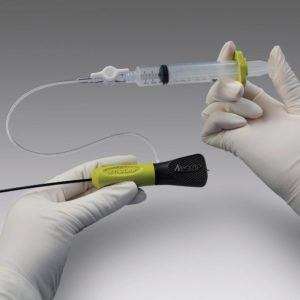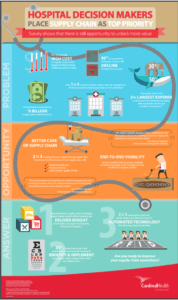Digitization in healthcare supply-chain is high-stakes; these are patient lives

When it comes to the healthcare industry, an efficient supply chain is critical to saving patient lives. Hospitals need the right products at the right time.
Improving the healthcare supply chain through digitization could give everyone in this world access to safer and more affordable healthcare, help hospital systems reduce costs, and “grow the opportunity pie” across the entire value chain. [1]
As healthcare costs increase across the industry due to inefficiencies including the continuing fee-for-service system, lack of interoperability, and reimbursement systems, hospital networks are continuously looking for ways to decrease costs while maintaining high quality care for patients. These networks are increasingly turning to distributors to help them find avenues to cut costs.
Companies like Cardinal Health strive to provide their customers with the most robust set of solutions and offerings to help them manage their hospital supply chain, so providers can focus on their patients. Cardinal Health is a $130 billion healthcare company in the business of improving the cost-effectiveness of healthcare through efficient distribution systems. Cardinal Health’s Medical Segment operations distributes to hospitals, ambulatory care and surgery centers, physician centers, and at-home patients every day. The portfolio of products include everything from surgical gloves and gowns to cardiovascular devices and surgical saw blades. [2]
Executives at top hospital systems today consider supply chain as a top priority. Supply chain costs are the second largest expense (30%) for healthcare providers, after employee salaries and benefits (50%). In managing inventory, annual waste is approximately $5 billion in expensive medical devices and equipment. By reducing supply chain waste, hospitals can reduce overall costs and deliver better quality of care for patients. [3]
The info graphic [4] sheds more light and detail into the survey findings on how critical an efficient supply is to hospital operations.
Be Fast & Innovative
As a distributor, Cardinal Health is required to be creative in their use of technology to provide just-in-time delivery and keep supply inventory low so they are able to help hospital networks streamline supply processes. Hospital systems are also looking for ways to track their inventory, and this requires integration of their data and spend analyses to help them make the best decisions for purchasing.
A very recent survey conducted by Cardinal Health last fall reported 18% of hospital staff seeing or hearing a patient being harmed due to lack of necessary supplies. In combining this with the fact that lack of complete visibility in supply chain is the primary obstacle to improving the supply chain, we see how critical a role digitization plays in advancement of supply chain technology. [5]
With the technology at our fingertips today, we are able to capture and use real-time data to make decisions across the entire supply chain. This transparency is critical to efficient operations – and keeping patients safe.
In step with the industry trend of consolidations, Cardinal Health recently acquired Wavemark, now re-branded Cardinal Health Inventory Management Solutions (CIMS). CIMS has helped hospital providers track medical devices in more than 1,000 hospitals and tagged more than 10 million products. The RFID-enabled and cloud-based software platform allows hospital systems to integrate their systems on one platform and has the technology to offer these systems complete visibility into their inventory status, usage, and ordering. [6] Hospital systems work together with Cardinal Health to implement the system and create a customized solution.
The software platform allows hospital systems to make better decisions on purchasing and stocking inventory, thus leading to lower costs of supply and more efficient ordering patterns. The centralized data also allows for further analyses on how efficient the system or individual hospitals are operating; this allows for identification of opportunities for cost reductions. By outsourcing their inventory management, hospitals, again, can focus on providing the best care for their patients.
Out of further anticipation of future digital innovations, Cardinal Health created a Healthcare Supply Chain Innovation Lab as well. The lab allows for R&D to create and build on current technologies to develop a strategic and comprehensive asset for hospital systems to reduce total cost of care. [7]
Blurring Industry Lines
As a surprise to no one, Amazon is moving into the pharmacy business. [8] It is only a matter of time before they begin to directly compete with distributors.
While Cardinal Health, among other competitors, have been aware of the recent movement for quite some time, the question still remains as to what the next moves are for distributors. Would a potential partnership with Amazon be in Cardinal Health’s best interests? Is that even possible given the competitive landscape?
Industry lines are blurring. The medical and pharmaceutical distribution industry of yesterday is no longer such a defined space. Technology companies like Amazon begin to enter the distribution space, Google is innovating massively in the healthcare consumer products space, etc. To remain competitive, companies like Cardinal Health need to be creative in their partnerships with not only healthcare players, but the Amazons of the world as well.
Word Count: 799
References
[1] “Strengthening Health Care’S Supply Chain: A Five-Step Plan”. 2017. Mckinsey & Company. https://www.mckinsey.com/industries/healthcare-systems-and-services/our-insights/strengthening-health-cares-supply-chain-a-five-step-plan.
[2] “Medical Product Solutions”. 2017. Cardinalhealth.Com. http://www.cardinalhealth.com/en/product-solutions/medical.html.
[3] “Survey Finds Hospital Staff Report Better Supply Chain Management Leads To Better Quality Of Care And Supports Patient Safety”. 2017. Cardinal Health News & Media. http://cardinalhealth.mediaroom.com/2017-02-15-Survey-Finds-Hospital-Staff-Report-Better-Supply-Chain-Management-Leads-to-Better-Quality-of-Care-and-Supports-Patient-Safety.
[4] “Hospital C-Suite Executives Are Hungry For Supply Chain Solutions”. 2017. Cardinalhealth.Com. http://www.cardinalhealth.com/en/essential-insights/hospital-supply-chain-survey.html.
[5] “Cardinal Rules For Supply Chain Excellence: Interview With Scott Nelson – DC Velocity”. 2017. Dcvelocity.Com. http://www.dcvelocity.com/articles/20170721-cardinal-rules-for-supply-chain-excellence-interview-with-scott-nelson/.
[6] “Cardinal Health™ Inventory Management Solutions”. 2017. Cardinalhealth.Com. http://www.cardinalhealth.com/en/services/acute/business-solutions/operational-solutions/inventory-management-services/cardinal-health-inventory-management-solutions.html.
[7] “Cardinal Health Launches New Health Care Supply Chain Innovation Center | Cardinal Health Integrated Logistics | Global Trade”. 2017. Globaltrademag.Com. http://www.globaltrademag.com/rfp/company_press_release.php?id=12.
[8] Farr, Christina, and Ari Levy. 2017. “Every Health Executive Now Needs An Amazon Strategy”. CNBC. https://www.cnbc.com/2017/08/14/every-health-exec-now-needs-an-amazon-strategy-.html.






This essay clearly explains a problem (hospitals face high costs due to inefficient supply chains) and a potential solution in Cardinal Health. I would be curious to understand whether hospitals are receptive to Cardinal Health’s business model and eager to outsource these supply chain capabilities. If hospitals are not receptive, what are the key barriers to adopting this system, and what are the risks associated with outsourcing these functions? It is interesting that Amazon and Google are getting involved in the healthcare space – it seems to me, however, that Cardinal’s service, especially if it includes major networks through which hospitals are inter-connected into networks, should be relatively “sticky” once Cardinal has achieved scale.
Thanks for sharing an insightful article and for highlighting such a critical topic. Digitization in healthcare supply chain is a really critical intervention to save lives. The public healthcare system in developing countries such as India are yet to leverage technology to make their supply chains effective and efficient and this is leading to significant loss of lives. In India, 45,000 mothers died last year (10 times the number in China), 800,000 babies died within their first month, 1.2 million children die before their fifth birthday [1]. This is no surprise given that in India, most of the population cannot afford treatment at private hospitals and public hospitals have abysmal infrastructure and quality of care. One of the key drivers of this lack of infrastructure is lack of availability of critical life-saving supplies at hospitals. In 2015, there were up to 90% gaps in availability of essential supplies such as oxytocin, misoprostol, amoxcillin and other antibiotics in public hospitals in a state called Bihar in India [2]. These supplies are essential to save pregnant women during delivery and newborns in critical conditions.
The Cardinal Health model is extremely relevant in these contexts. The government is currently trying to implement a digital Hospital Management System to ensure transparent tracking of stocks for drugs, equipment, commodities and consumables but has a long way to go. I think there is huge potential for organizations such as Cardinal Health to step in here and get the government to outsource management of supply chain at public hospitals to them. I was very impressed to read and learn about how Cardinal Health is leveraging technology to help hospital networks streamline supply processes especially how they are capturing and using real-time data to make decisions across the entire supply chain. This transparency is critical to efficient operations and just what is needed by developing countries like India with broken healthcare systems to keep patients safe.
[1] UNICEF Progress Report 2013
[2] Government of Bihar – Hospital Management Information System 2015 Report